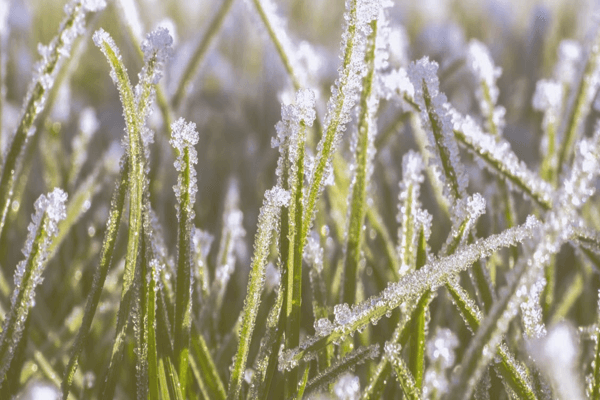We all know a lawn full of fresh green grasses can give an aesthetic look to any house, right? But, here’s the catch. In the winter, it can also be a cause of worry because grasses tend to die due to harsh frosts. That’s pathetic for an amateur homeowner!
Well, not to worry! Protecting your grasses from frost is no complicated job at all. The core technique is to strengthen the grasses enough by applying water and additional fertilizers so they can withstand the frosty low temperature.
In addition to revitalizing the grassroots, you also have to maintain some habits in order to prevent the total destruction of those green vegetation. For this reason, some tips from experts have to be followed too (cited in the discussion below). So, let’s get to know more!!!

You May Like: How To Stop Weeds Growing Through Pebbles
Contents
Why Does The Frost Damage Your Favorite Lawn?
Well, as winter falls at night, the low temperature freezes the moisture and water molecules inside the grass leaves. This process solidifies the leaf body from the inside out.
This can occur for several nights. As a result, when a person or animal walks on those grasses, the grass leaves shatter into pieces. So, as you can see, grasses are pretty helpless in the times of winter.
A positive side is, grassroots actually can survive very well even in the winter. As the upper body of the grass is damaged from the cold, the roots try to repair the whole body.
If it’s unable to do so, the grassroots go into dormancy and do not regrow until the warmer season comes.
So if you love your lawn and want to see it green even in the winter, then you have to follow certain steps to protect these grasses from frost. Read on to find out these steps.
How To Protect New Grass From Frost?
The good news is, even though winter can cause a lot of harm to your lawn, following the below steps, you can save it. So, let’s hear them out:
1. Making a sidewalk/driveway
As the grass blades are completely frozen and solidified, any animal or person walking on the lawn is genocide for those grasses. The same goes for driving a car on the lawn too.
This is why we recommend immediately making a sidewalk or driveway beside your lawn so you can leave the grasses alone.
Make sure your pet doesn’t walk on the lawn, which can also be very helpful if you want to save your lawn glasses.
Plus, when you are entering your house by your car, don’t forget to use the driveway instead of trampling the grass with those tires.
2. Watering the grasses
Keeping your grasses fully hydrated is a pretty good way to defend against light frost. If the grass leaves are hydrated enough, they can protect themselves for a longer period of time from frost. The best time to do watering is in the evening period of the day, right before a frost in the nighttime.
On top of all that, the grassroots that are already fighting to grow back get a little more push to further regrow. This is why in order to stay protected from frost, it is the experts’ recommendation to keep the watering going on even in the winter.
3. Providing a cover
If your lawn has some fresh or newly born grasses, it is a really good idea to cover them at night so they don’t get frosty so easily. You can use peat moss to insulate the new grasses. A bedsheet can also do the trick for the time being.
It is better to not use plastic tarps because they can freeze up and further worsen the frost situation.
4. Fertilizing the land in perfect time
It is extensively helpful if you fertilize the lawn during the autumn season. It is a practice that most people forget to complete. But it is massively helpful to your grasses.
As dewdrops mix with the applied fertilizer in the morning, the boosted soil energizes your grasses to grow very fast just before the winter, which will render your lawn a greenish and lively look even in the winter.
Also, your grasses will have extra strength to sustain themselves even in very low temperatures because of the nutrients from the added fertilizer.
More on LivingProofMag
How Long Does Roundup Take to Work
How Long Does Vinegar Last in Soil
Best Weed Killer for Driveways
FAQs
Is It Okay To Mow After A Hard Frost?
Routinely mowing your lawn is actually very healthy for your lawn grasses. But in the winter, when the grass blades are frosted and brittle, it is absolutely a bad idea to mow right after a frost. If you mow the brittle grasses, you will only further delay the process of their re-growing.
So, when should you mow in the winter? Well, it is ideally thought that 40° F is the right temperature for mowing the lawn.
Mind you, it is good to trim your grasses to the shortest size before the first frost happens. This is why you should plan to make the last mow just 1 week before winter falls.
However, if you absolutely have to mow your grasses in the winter, wait till the sun is up and the temperature is high enough, probably around midday when there is no frost at all.
Is it possible for new grass seed to survive a frost?
In short, YES. Grass seeds have the ability to survive through very low temperatures. They have a dormant state feature to protect themselves in the time of high cold. In winter, the grass seeds will go inert and stop growing. They will wait until the temperature rises again.
But because new seedlings are very young, they might have certain difficulties withstanding the cold. This is why we recommend taking care of the new seeds a few weeks before the first frost.
Does frost occur in grass seeds?
Technically, YES. But practically, NO. Grass seeds can physically freeze up and stop growing. But it does not mean they are dead. They simply go into hibernation mode and wait for the warm season to come. You’ll see the seeds growing perfectly when the summer arrives.
Is it okay to plant grass seeds before a frost?
Yes, it is okay to do that. But be sure to plant the new seeds at least 5 to 6 weeks prior to the first frost. As the new seedlings take a little time to grow roots, you should give them at least 6 weeks to get a stronghold of the soil.
Although new seeds can go dormant in the winter, most of them are too weak to protect themselves in the cold. It is, therefore, better to give them a few weeks of time to grow into strong grasses so they can withstand the winter just fine.
Can we grow grass seeds after the first freeze?
Typically there is a “sprouting temperature” range for the grasses to grow.
In summer, dresses will grow if the temperature is above 70° f. But in winter, they can grow if the temperature is between 40° f and 70° f. So, as long as it’s not too cold, grasses can grow even after the first freeze. But for that to happen, the temperature has to stay steady.
If the temperature is oscillating up and down, it becomes harder for the grasses to grasp the weather and grow any further.
Final Words
Well, there you have it, people. Hopefully, you’ve got a clear understanding on how to protect your new grass from frost if you’ve gone through the article carefully.
Remember that if you are a person who loves your lawn, winter is not your best friend. But following the above-mentioned tricks can help you get a greener lawn even in the winter. In any case, if you see your grasses dying out completely, seek the care of horticulture specialists to tackle the problem permanently.
It was a pleasure being of help to you, have a nice day, thanks!!!
